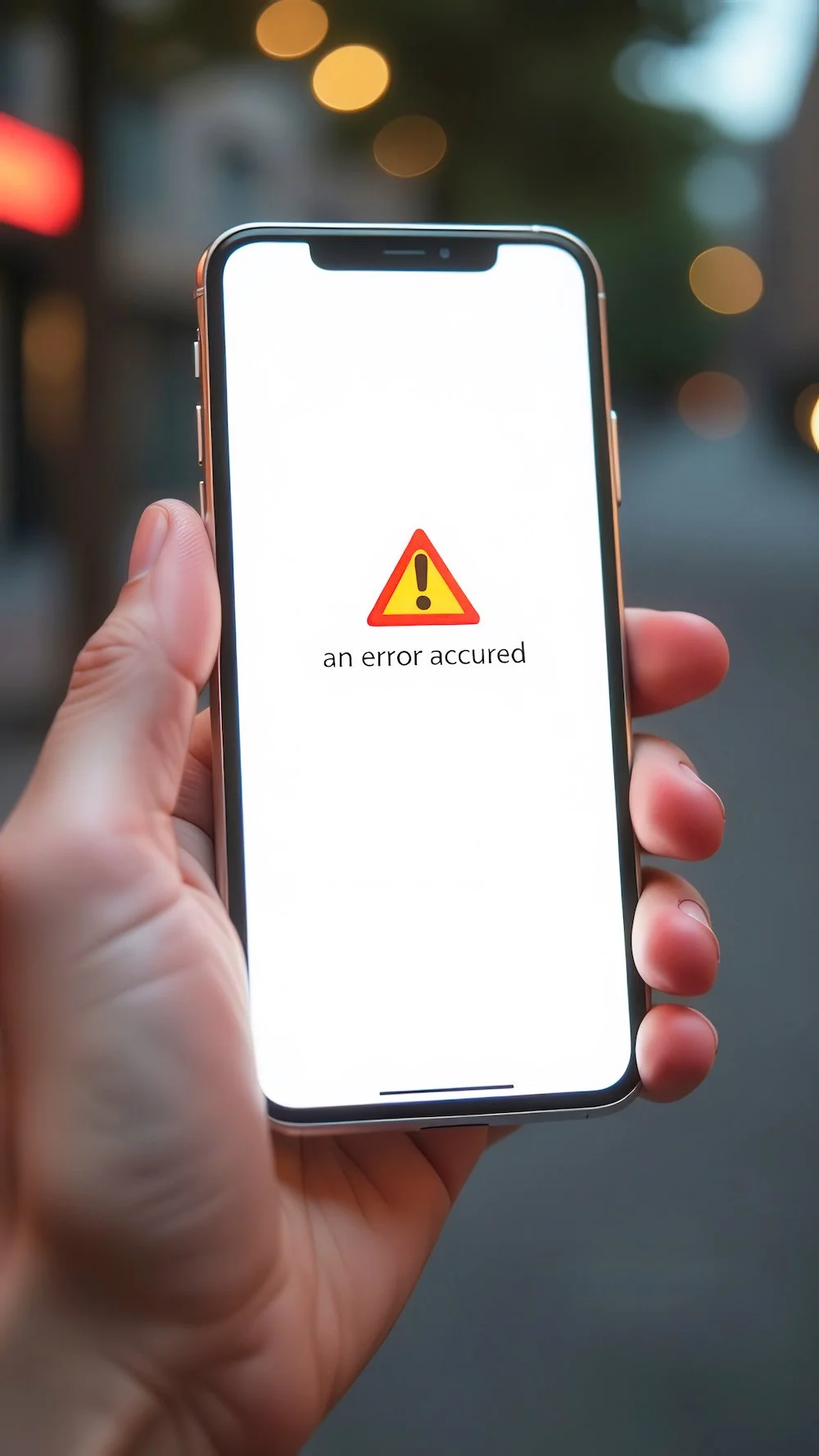What could possibly go wrong?
Things don’t always go to plan. How you react when the unthinkable happens (check-in goes down is this case), shapes the attendee experience and overall impression on the day.
Fifteen minutes before doors, the check-in area looked calm.
No desks, just four roped-off columns guiding people in.
Pre-printed QR lanyards hung on racks, colour-coordinated by registration type so staff could grab the right one quickly.
Delegates had their personal QR code in the event app (iOS/Android) or the PWA in their browser.
The team used the admin view to scan that personal QR and assign a lanyard QR from the rack. No names printed; identity lived in the mapping. Later, exhibitors would scan the lanyard to capture leads against the right person.
Clean loop. Fast queue.
Then the app hesitated. A spinner here. A frozen screen there.
Mutterings came from the queue as they tried to access the app from their phones.
There was a Plan B, a standalone check-in system, but with check-in already open and four columns moving, swapping systems mid-flow is like changing tyres while still rolling: possible, not graceful.
So the delegate team used their experience.
They opened the offline attendee list synced an hour earlier and kept people moving by name and company while two colleagues worked on recovery. Venue Wi-Fi wobbled; hotspots stepped in. Front-of-house used one calm line:
“We’re checking in manually for a few minutes, thanks for your patience. We’ll get you in as quick as we can.”
About ten minutes later (and thanks to the on-call tech support team), the app recovered.
Assignments continued: personal QR → lanyard QR.
The room filled. From the outside, it looked smooth.
From the inside, the lesson was clear:
Plan B isn’t a different system. Plan B is the same journey, by another road.
With no printers on site, lanyard QRs pre-printed and colour-coded, and four roped columns instead of desks, the critical link was the mapping between personal app QR and lanyard QR. If the back-up can’t preserve that mapping in the moment, data breaks and lead capture suffers.
Here’s how smart teams now design for that reality.
What to copy if you run events
1) Hot-swap, not hard switch
Back-up should live inside the same check-in flow: in this case, scan personal QR → assign lanyard QR → log the mapping. If the event app/PWA wobbles, an offline mode uses cached data on the very same screens. No re-routing the four columns. No new instructions.
2) Cache the right data
Before doors, admin devices cache:
attendee list and personal QRs,
lanyard QR ranges by registration type,
existing assignments.
If connectivity drops, offline check-in continues and syncs later.
3) Protect the mapping
With no names on lanyards, the mapping is everything. Treat “person QR ↔ lanyard QR” as sacred. Even if you pause to check people in by name for a few minutes, allocate the correct lanyard QR and record it for reconciliation.
4) Flip criteria + a drill
Agree the line: “If X% of scans fail for Y minutes, flip to offline.” Practise the swap the day before. Pull Wi-Fi. Pause the app. Keep the queue moving across all four columns.
5) Roles beat heroics
Who calls the flip? Who controls the four columns? Who talks to the organiser? Who liaises with the platform team? Say it out loud in the briefing. Twice. Print the FOH script.
6) ‘Essentials’ page for delegates
When the attendee app misbehaves, a lightweight web page with agenda, room map, Wi-Fi code, help number and a fallback QR keeps things calm. Put the URL and a QR on signage near the ropes.
7) Incident log
Start a timer, note what failed, what was tried, what worked, and what will change. That’s how you remove luck from the next event.
Edge cases worth assuming
App/PWA stalls (delegate or admin): admin continues on cached data; delegates present a fallback QR from the Essentials page; QR-to-QR assignments continue.
Venue Wi-Fi sulks: hotspots take over; if both links die, offline mode continues and syncs later.
No printers on site: still fine, lanyards are pre-printed and colour-coded; maintain the mapping and reconcile afterwards.
Attendee not on list: quick-add on a cached form; allocate a lanyard QR; dedupe later.
VIPs: pre-pulled, clearly labelled lanyards by colour/type.
Unexpected evacuation: grab-sheet headcount by alphabet band; reconcile afterwards.
The point
Event check-in should look calm, even when the tech has a moment.
That doesn’t happen by luck. It happens when Plan B keeps the same journey alive, scan, assign, log, online or offline, printers or not, desks or roped columns.
Make the plan. Pack the kit. Practise the swap.
Queues move. Stakeholders relax. Lead capture survives.
Copy-paste checklist for organisers
Admin devices cache attendee list, personal QRs and lanyard QR ranges at T-60
Back-up uses the same scan → assign → log journey
Two networks tested on site (venue + at least one hotspot)
FOH one-liner printed and rehearsed (visible near the ropes)
Essentials page live (agenda/map/Wi-Fi/fallback QR) and signage updated
Flip criteria agreed (X% failures for Y minutes) + ten-minute drill done
Incident log template open; fixes assigned post-event
The new NPS dashboard in Mitingu
Most feature releases are dull. Here’s one that isn’t. The new NPS Dashboard in Mitingu doesn’t just add another button. It tells you if your event was any good. Not based on guesswork, but on what your attendees actually thought.
Registration numbers don’t tell you if your event was any good.
They just tell you who turned up.
What really matters is what people thought when they left. Did they love it, hate it, or just shrug and move on?
That’s why we’ve built NPS dashboards into Mitingu. It’s the simplest way to stop guessing and start knowing.
Why NPS matters in events
Consistency: One set of questions, one scale, every event.
Clarity: A single score that tells you if the event was a success (or not).
Confidence: Compare results across accounts, regions, and globally.
What you’ll see in the dashboard
Event view → Headline NPS, a funnel from Registered → Attended → Surveyed → Responded, and a clear split of Promoters, Passives, and Detractors.
Account/region view → Roll-up scores across multiple events, trends over time, and heatmaps by country.
Global view → A complete picture across your organisation: NPS by country, region, and account, plus top and bottom performers.
The bigger picture
The NPS dashboard goes beyond reporting. It’s a feedback engine.
By standardising a set number of simple survey questions, every event can be measured, every trend can be spotted, and every decision can be backed by real data, not gut feel.
So if you want to stop saying “I think the event went well” and start saying “Here’s the evidence”, this is where you begin.
Want to see how the NPS dashboard could change your event reporting? Let’s talk.
Stop rushing events. Start knowing what works.
Event organisers are busy people. Too often, one event finishes and it’s a case of on to the next. No time to pause and reflect on what works and what doesn’t. We can help with that.
Event organisers are busy people.
They finish one event and sprint to the next.
Deadlines, checklists, last-minute fires.
But here’s something no one talks about.
No one really knows how the last event went.
What worked? What flopped? What did attendees say?
And most importantly, did it move the business needle?
If you’re organising events but can’t answer those, you’re guessing.
And guessing in business is expensive.
Why you need to track event ROI and feedback
You’re not just throwing a party. You’re spending budget, time, and reputation.
So you have to know: is it worth it?
Tracking how your events perform over time, collecting real attendee feedback, and measuring return on investment isn’t optional.
It’s critical.
Mitingu makes it simple
No more spreadsheets. No more random feedback forms lost in inboxes.
Mitingu puts everything in one place.
Instant analytics. Clear reports. Trends across events.
You see what’s working and what’s not.
So you can stop guessing, and start improving.
The power of the pause
Pause for a moment.
Don’t just jump to the next event like it’s a race.
Reflect on data, learn, apply.
Your events deserve more than a blink-and-miss approach.
Ready to get real about your events?
If you want to be more than busy, if you want to be effective, Mitingu is for you.
Cut the noise. See the facts. Make the right call every time based on facts and figures, not hope.
"Create an event site in under 10 minutes." Yeah, right.
Custom registration sites and flows take a smidgen longer than 10 minutes to create. Here’s a quick starter list of things you’ll need to kick things off in the right way.
Scenarios where that's possible:
• A basic event collecting just name and email (maybe)
• A straight copy of a previous event (seconds to duplicate, minutes to tweak)
• Cloud cuckoo land for anything remotely complex
Platforms like Mitingu can speed things up when used properly, but a registration process with custom flows and dynamic comms? That takes proper planning. Rush it and you're asking for a sh*tshow on launch day.
Look, you're an event planner. You know that details matter. The same obsessive planning you put into venue logistics? Your registration flow deserves that too.
Jumping onto any platform and winging it won't work. Here's what you actually need sorted before you start:
✅ Details of the event, including expected capacity - what do they want to do with registration, what do they want to capture
✅ What they are charging for the event, or if it's free
✅ Branding/Brand guidelines
✅ List of registration types needed
✅ List of questions that need to be asked and to whom - could be based on the type of registrant
✅ List of types of emails you want to send. E.g., Save the Date, Invitation, Reminder, Booking Confirmation, etc
✅ Any other required custom functionality
This list isn't exhaustive, but nail these basics first. Content and assets can follow, but without this foundation? You're building on sand.
Questions about getting your registration right? Drop us a line.
Low Attendance Series – Part 5: How timing impacts attendance (and how to pick the right date)
The final part of our low attendance series. How bad timing can kill even the best of events. We share some tips on how to get it right.
Even the most compelling event won’t succeed if it’s at the wrong time.
In the final part of our Low Attendance Series, we look at how when you schedule your event can make or break your numbers.
Bad timing is a silent killer
Common (but avoidable) pitfalls:
Clashing with major industry events or holidays
Fridays that feel like a soft out-of-office
Mondays that feel too soon
Use tools like Google Trends or, if you’re a Mitingu client, past event data to find the most likely times for success for your audience.
Test multiple dates
If your audience is tight-knit or internal, poll them.
Mitingu’s pre-registration tools make it easy to gauge date preferences before you commit.
Think micro-timing too
Breakfast sessions are great for execs
Lunch & learns suit internal teams
After-work slots favour casual networking
Bonus: Use calendar-friendly invites (automatically generated by Mitingu) to boost actual attendance, not just RSVPs.
Final thoughts: Low attendance doesn’t have to be inevitable
From comms and content to speakers, venue, and timing, you now have a blueprint to reverse low turnout and deliver high-impact events.
If you’re still doing this manually or working with multiple tools, it might be time to try something better.
Want to fix low attendance for good?
Let Mitingu show you how high-performing events are built.
Low Attendance Series - Part 4: Venue psychology – Why the where matters
The venue? “We’ll go for the same as last year, that was ok.”
Ok might not be good enough this year. Our take on why we think the venue can tank numbers or make them fly high.
Think the venue is just a backdrop that doesn’t need as much thought? Think again.
Your choice of location says everything about your event’s purpose, tone, and perceived value to the people you want rocking up to it.
In Part 4 of our Low Attendance Series, we dive into the subtle cues your venue sends, and how they can affect turnout.
Venue signals intent
A hotel conference room might say “corporate and efficient”
A rooftop bar says “networking and cool vibes”
A private dining room says “selective and high-value”
Even before they arrive, attendees are making assumptions about:
Who else will be there
How formal it’ll be
What they’ll get out of it
Use those assumptions to your advantage.
Make the venue a hook
If you’re using a standout venue, lead with it.
“Join us at The Shard for an exclusive fintech briefing”
“Connect with big-hitters over cocktails at The Ned”
If not, highlight why the venue was chosen:
“Hands-on session in an innovation lab, not a boardroom”
“Just 5 mins from London Heathrow [key transport hub]”
Use visuals in promotion
Don’t just describe the venue, show it. Make it easy for them to visualise being there and getting there.
Mitingu event pages support embedded galleries, and email templates can include venue photos, Google Maps embeds, and travel guides.
Next in the Series…
Part 5: How Timing Impacts Attendance (And How to Pick the Right Date)
Low Attendance Series – Part 3: Are you picking the wrong speakers?
Getting the wrong speakers for your event can kill attendee numbers. Relevance beats fame.
You’ve got the right venue, you’ve pushed the comms, and you’ve reframed the topic.
But still, people are hesitant to register, and the numbers just aren’t there.
The problem might not be what you’re saying, but who’s saying it.
In Part 3 of our Low Attendance Series, we cover how speaker choice can make or break your attendee numbers, and what to do if your lineup isn’t exactly front-page material.
Great speakers don’t have to be famous; they have to be relevant
Yes, big names can draw in the numbers initially, but relevance often outperforms it.
A niche expert who solved a relatable problem will outperform a “celebrity” speaker no one relates to.
An internal champion or customer with real-world results can deliver more impact than a consultant who speaks in generalities.
Tip: When promoting speakers, don’t just share their title—share what they’ll teach and what the audience will get out of it.
“How Rachel from ABC Ltd reduced waste by 38% in 6 months.”
People want people like them
Speakers who feel relatable make your event feel more accessible.
Ask:
Will this speaker resonate with the type of audience that we’re targeting?
Can they connect emotionally, not just deliver slides? Charisma is a wonderful thing.
And if you’re worried about low name recognition, use storytelling in your comms to raise their profile before the event.
Promote the speaker, not just the agenda
In your comms:
Include speaker photos and relevant quotes or achievements in emails
Create short preview videos or Q&A snippets
Use pull quotes as social graphics (Mitingu templates help automate this)
Coming Up Next…
Part 4: Venue Psychology - Why the where matters
Low Attendance - Part 2: Your event subject might be the problem
Why a dull subject line on your event comms can be an engagement killer. A few ideas on how you can reframe subject lines to improve response rates and encourage more sign ups.
We’ve all been there. You’re hosting a business-critical event. The logistics are tight, the venue’s locked in, and you’re promoting it across all the right channels.
But registrations are trickling in. Attendees aren’t biting. The powers that be want to know why.
Here’s the harsh truth: it could be the event subject that’s turning them away.
In Part 2 of our Low Attendance Series, we dig into why even important topics fall flat and what you can do to make them feel urgent, engaging, and hard to resist for the right audience.
Not every topic is sexy, but every topic can be sold
Let’s say your event is about:
Regulatory updates
Internal process improvements
Cybersecurity protocols
Procurement system changes
None of these are “headline grabbers.” But they are important.
The solution isn’t to change the topic—it’s to reframe it through the lens of your audience.
Reframe from feature led to outcome
Your attendees don’t care what you’re covering. They care why it matters to them, the “what’s in it for me?” factor. Here’s a couple of examples:
DON’T “Q3 Compliance & Risk Briefing”
DO “How to avoid the fines: What you need to know before Q4”
DON’T “Procurement portal update”
DO “Slash 3 Hours off every vendor approval this year”
Focus on problems solved, time saved, money gained, risk avoided, not just a rigid subject line.
Use Emotion + Logic
B2B audiences are no different from other audiences; they make decisions emotionally first. Tap into that.
Use phrases like:
"Stop wasting time on admin…"
"Avoid becoming the next case study in failure…"
"Here’s what your peers already know and you don’t."Back it up with stats:
“72% of companies that fail cyber audits missed these 3 steps.”
A little plug for us! Mitingu lets you personalise subject lines and messages into segmented email flows, so each persona hears the version that resonates most.
Bring in people, not just content
Sometimes the subject doesn’t change, but the messenger does.
A customer story or internal champion can bring a topic to life
Instead of “talking about compliance,” have someone share how they navigated a tricky audit
Use case studies, testimonials, and real results in your comms
Spoiler alert: That’s the topic of Part 3, coming next week.
Using this approach not only makes your messaging more engaging, it’s also more likely to encourage more registrations, higher attendance, and better post-event feedback.
Low Attendance - Part 1: Why comms could be tanking your event numbers
Find out how event comms could be one of the reasons for tanking your attendance rates and how to fix them.
You’ve planned a great event. The logistics are solid, the speaker lineup is strong… but your registrations are flat, or your confirmed attendees just don’t show up.
Before you blame the date, the market, or the moon, take a look at your event communications. They're often the silent killer of attendance.
In this first part of our Low Attendance Series, we’ll take a look at how strategic comms can transform interest into action, and some of the mistakes that might be costing you bums on seats.
Comms are more than just sending an invitation
Too often, event comms are treated as a tick-box exercise:
1. Send an invite
2. Send a reminder
3. Cross fingers and hope for the best
But communications are not just a way to inform, they’re your tool to create interest, urgency, and get some commitment. And if they’re poorly timed, irrelevant, or forgettable? Your response rates will reflect that.
Fix 1: Lead with relevance
Your audience doesn’t care about your agenda (yet). They care about what they’ll get out of it.
Change:
❌ “Join us for a leadership summit”
✅ “See how FTSE 100 execs are future-proofing their teams”
This kind of shift makes your messaging feel personal, specific, and hard to ignore. They can see what they get out of it.
Fix 2: Use the right channels for the right audience
Not everyone responds to email. Nowadays, getting your email noticed and read is an achievement in its own right.
Consider printed, personalised invitations.
These feel premium, cut through digital noise, and are designed drive them offline to online—straight to your branded Mitingu registration site (sorry about the plug!) via QR code or a short/personalised URL.
Ideal for: C-suite dinners, private tastings, exclusive roundtables.For a younger, mobile-first crowd, SMS or WhatsApp reminders might receive a better response than an email they’ll possibly never read.
Use LinkedIn DMs or custom audiences to re-target past attendees. The messaging has to be original to avoid being seen as yet another LinkedIn spammy DM.
Fix 3: Plan a comms journey, not one-off hit and hope blasts
Effective events use a drip-style approach to warm up and lock in attendees:
Initial Invite - Grab their attention and hook them with something of value to them
Reminder 1 - Add a relevant and original teaser (VIP speaker reveal, topic highlight)
Reminder 2 - Use social proof (“1,200 have already signed up”), it has to be accurate or you’ll get found out!
Final Push - Urgency (“Last 10 spots available”). As above, make it real, or they’ll find you out in the day.
Updates - Share helpful info like how to get there, generate excitement and expectation by reminding them what to expect and what they will get out of it.
Coming Up Next in the Series
In Part 2, we’ll look at how the event subject or theme itself could be turning people off, and what to do when your topic isn’t “sexy” but still important.
Future posts will cover:
Part 3: Are you picking the wrong speakers?
Part 4: Venue psychology – why the where matters
Part 5: How timing impacts attendance (and how to pick the right date)
Stop wasting time on events without measurable targets!
Running a business event without a clear reason why and a set of metrics that you can measure its success against could be a complete waste of time and money. Some suggestions that could help.
Businesses love events. They splash out on venues, catering, branding, and overpriced lanyards. They get their sales teams suited and booted, send them in to schmooze, and then pat themselves on the back for ‘putting themselves out there’. But let’s be honest, most of these events are nothing more than glorified social gatherings with an expensive price tag. Why? Because they have nothing to measure their success against.
Why do businesses run events?
Simple, ego and tradition. Someone in a suit once said, ‘We need to be at that trade show’ or ‘Let’s host a networking event’ and nobody challenged them. The idea of a flashy stand and branded freebies sounded too good to resist. But ask them, ‘What’s the objective?’ and you’ll get vague nonsense like ‘brand awareness’ or ‘building relationships’. That’s code for ‘We have no idea, but we’ll pretend it’s strategic.’
Here’s the reality: Events should exist for one reason: drive results. If they don’t, they’re a colossal waste of money, time, and effort.
3 ways businesses generally engage with events
Businesses typically interact with events in at least one of the following three ways:
Running their own event – This could be a conference, a networking session, or a private event designed to attract and engage prospects. If you’re doing this, you better have a clear strategy to generate sales. If it’s just a vanity project, cancel it now.
Exhibiting at someone else’s event – Whether it’s a trade show, an expo, or an industry exhibition, standing around hoping people stop at your booth isn’t a plan. What’s the lead target? How will you convert attendees into actual business? If you can’t answer that, you’re just paying for an expensive branding exercise.
Attending an event as an attendee – If you’re sending your team to a conference or networking event, what’s the goal? Are they there to actively generate leads, book meetings, and create opportunities? Or are they just ‘representing the company’ (which is code for doing nothing measurable and having a nice day out)?
No targets, no accountability
Most businesses don’t set measurable targets for events. They ‘hope’ for leads. They ‘hope’ for good conversations. They ‘hope’ it all works out. Hope is not a strategy. If you can’t define what success looks like in clear, measurable terms, you’re setting yourself up to fail.
Try asking these questions before your next event:
How many qualified leads do we need to generate to justify the spend?
How many meetings should be booked as a direct result?
How many follow-ups will convert into sales?
If you can’t answer these, then why are you running the event at all?
Events should be sales machines, not social clubs
The only reason to run an event is to increase revenue. That means:
Every interaction should have a clear next step.
Sales teams should be actively qualifying/disqualifying, not just having ‘nice chats’.
There should be a follow-up plan that is executed with military precision.
Results should be tracked and measured against the spend.
If an event doesn’t generate a tangible return, it’s just a very expensive day out for your team.
Set clear, measurable targets
If you’re running and/or attending events, do it properly. Define KPIs before you even book the venue.
Lead Generation: How many qualified leads should come from the event?
Conversions: How many should turn into paying customers?
ROI: How much revenue should the event ultimately drive?
Once the event is over, measure against these targets. If it didn’t hit them, something needs to change.
Be brutal about results
Businesses waste fortunes on events that make them ‘feel’ busy without delivering actual results. If you’re running an event without measurable targets, you’re just another company burning cash for the sake of appearances.
Make events work for you, set targets, track results, and if it doesn’t bring in revenue, make a change or stop doing it. Simple.
How can we help?
The bad news is that we can’t wave a magic wand, get people to your event, keep them engaged and deliver a great return on investment to the powers that be, but… we can give you the tools to help you make it happen.
Just give me the numbers
Event planning is chaotic enough without having to dig through endless dashboards for registration updates. Imagine starting your day with a simple email, just the numbers, no fluff.
Every event planner knows the feeling. You’re juggling a hundred things at once… venue logistics, speaker confirmations, catering, and the ever-present feeling in the pit of your stomach that something, somewhere, is about to go horribly wrong.
And then there’s registration. The lifeblood of your event. The numbers that tell you whether all your efforts are actually paying off.
So why, in the name of all things efficient, do planners have to go digging for that information? Who wants to log into a piece of software five times? Not me!
The power of a simple email
Imagine this. Every morning, while you sip on your oat latté (other beverages are available), an email lands in your inbox. No fluff, no unnecessary noise, just the numbers you need.
Total registered attendees
Total declined invitations
Any updates—who changed their details, who dropped out, who swapped their session choices
That’s it. No logging into platforms throughout the day, no sifting through reports, no navigating around the software. Just the numbers you need, when you need them.
Why it’s a game-changer
You see what’s going on in real-time
Registrations plateauing? A sudden spike in declines? These aren’t just stats, they’re clues. They help you spot issues before they become problems. If interest is stalling, you adjust your outreach. If dropouts surge, you dig into why.You respond faster
An attendee swaps their meal preference, upgrades their ticket, or cancels altogether. If you know right away, you can act right away. No surprises. No last-minute scrambles.You allocate resources more efficiently
Catering, seating, materials, all of it depends on knowing who’s coming. Daily updates mean you can fine-tune quantities, avoid waste, and optimise spend.Stakeholders stay in the loop
Sponsors, vendors, internal teams, everyone, and their dog wants numbers. A daily digest keeps you one step ahead, with the latest stats at your fingertips. No more “I’ll check and get back to you.” You already know.
Automation is your friend
The beauty of this? It’s not hard to set up. Automated reports exist for a reason. They save time, cut out manual data digging, and make sure nothing slips through the cracks. The right system does the work for you, freeing you up to focus on making your event the dog’s do-dahs.
The bottom line
Event planning is already complicated and stressful enough. Getting critical data shouldn’t be. A daily/weekly (or even in real-time) email with just the numbers means you stay informed, react faster, and run a smoother, smarter event, that makes you look like a susperstar.
So yes, just give me the numbers. And let’s get on with the real work.
Mitingu plug time - we make it easy to do all of the above (of course we do, we’re writing about it), give us a nudge if you’d like to find out how.
A simple communications plan for your events
An event communications plan. Here are some ideas on how to engage attendees with clear, strategic messaging before, during, and after the event.
Ok, so we’ll start with the bad news! Without clear and consistent communication, you risk low attendance, confused attendees, and missed opportunities to build engagement before, during, and after the event.
The good news is that creating a communications plan, even if it’s just a simple one, can make a big impact by making sure attendees are well-informed, engaged, and prepared.
To illustrate this, let’s take the example of a corporate networking event where guests are invited to register in advance. Below is a basic yet effective example communications plan that could easily be implemented. This is purely email-based, but it could use a multi-channel (print, email, and SMS/WhatsApp) approach depending on the event and the budget!
Example Event Communications Plan: Corporate Networking Event
Pre-Event: Invitations & Registration Reminders
Initial Invitation Email (4 weeks before the event)
Subject: Join Us for an Exclusive Networking Event!
Content: Highlight event details (date, time, location, key speakers, and benefits of attending). Include a clear call-to-action (CTA) with a registration link.
First Reminder Email (2 weeks before the event)
Subject: Time is Running Out – Register for Our Networking Event!
Content: Reinforce the event’s value, mention any new updates (such as confirmed speakers or special guests), and encourage those who haven’t registered to sign up.
Final Reminder Email (3 days before the event)
Subject: Last Chance to Secure Your Spot!
Content: Urge last-minute registrations, provide logistical details (venue, parking, dress code), and remind registrants to bring business cards.
Post-Registration: Keeping Attendees Informed
Confirmation Email (Immediately after registration)
Subject: You’re Registered! Here’s What You Need to Know
Content: Thank the participant for registering, include event details, and provide a calendar invite. Mention any resources they should review before attending.
Event Reminder Email (1 day before the event)
Subject: We Can’t Wait to See You Tomorrow!
Content: Include final logistical details, event agenda, and a point of contact in case of questions.
Morning-of Email (Day of the event)
Subject: Today’s the Day! See You at [Event Name]
Content: A brief motivational message, venue access instructions, and a reminder to network and engage on social media using the event hashtag.
Post-Event: Feedback & Follow-Up
Thank You & Feedback Request Email (1 day after the event)
Subject: Thank You for Attending – Share Your Thoughts!
Content: Express gratitude, share event highlights or photos, and request feedback via a short survey. Offer an incentive (e.g., entry into a giveaway) for completing the survey.
An additional option - A Giveaway communications plan
To increase engagement, a giveaway could be part of the event registration and engagement process. Here’s an example of how it could be communicated:
Announcement Email (2 weeks before the event)
Subject: It’s a WIN WIN at our Relaunch event!
Content: Explain the giveaway, how attendees can enter (e.g., registering, attending, engaging on social media), and reveal the prize.
Reminder Email (3 days before the event)
Subject: In it to win it
Content: Reinforce the giveaway details, include instructions, and generate a bit of buzz and excitement.
Live Event Announcement (During the event)
Method: Social media posts, event host announcements, notifications via an app
Content: Encourage participation, showcase entries (if applicable), and keep their eyes on the prize.
Winner Announcement (Post-event, 1 day after event)
Subject: We have a winner!
Content: Say a big congratulations to the winner, thank all participants and encourage them to stay connected for future events and giveaways.
Why bother?
A well-structured communications plan gets rid of uncertainty and keeps your audience engaged throughout the event journey. Proactive communications create a smoother and more positive experience for attendees. Even with a simple plan, clear and regular communication builds better participation, strengthens attendee buy-in, and increases the overall success of your event.
Business events have changed. Have you?
The business events landscape is evolving fast. Attendees expect more, sponsors demand more and it’s down to the event planner to deliver.
If you’re still planning events the same way you did five years ago, it’s time to think about a reset.
Business events are no longer just about putting people in a room with a name badge, a lanyard and leaving them to their own devices. Attendees expect more. Sponsors demand more. And event planners? They’re juggling it all, while somehow making it look easy.
But here’s the reality:
Attendees are bored of static presentations and outdated networking formats.
Sponsors want '“bang for their buck”, not just a logo on a banner.
Tech should make things easier, not harder (yet here we are, switching between five different platforms just to organise one event).
What’s Changed?
Attendees expect interactivity. 99.9% have smartphones, utilise it. They want live Q&As, networking that doesn’t feel forced, and on-demand access to content.
Seamless tech is a must. No more queuing at check-in, lost agendas, or payments going missing. Everything needs to be integrated.
Data matters. If you can’t measure engagement, track foot traffic, or give sponsors the numbers beyond “people saw your booth,” you’re falling behind.
The Future of Events Is Smarter (And Less Stressful)
The best event professionals are already shifting to:
Event platforms that do more—registration, ticketing, communications, payments, and analytics all in one place.
Real-time data that actually helps you make decisions (instead of spreadsheets that nobody updates).
Sustainable events with the ability to stand by their ESG data.
So, What’s Next?
If your tech still makes your job harder, it’s time to rethink how you’re running events. Because the planners who adapt? They’re the ones delivering next-level experiences, without the last-minute panic.
The art of the backup plan: What to do when event check-in goes wrong
We share some well trodden strategies for handling event check-in disasters with confidence. See how having a Plan B can be a life (and event) saver.
Event organisers thrive on the thrill of seeing months of planning come to life. From unique attendee experiences to flawless decor, every detail matters. But if there’s one thing seasoned professionals understand, it’s the importance of having a backup plan. Because when event check-in goes south (and it inevitably will at some point), being ready to pivot with grace and confidence is key.
Expect the unexpected
Murphy’s Law is ever-present in the world of events, anything that can go wrong will go wrong, and check-in is a prime area for potential disaster. System glitches, power outages, wi-fi failures, and missing attendee lists are just a few of the common challenges. The best strategy? Expect the unexpected.
Digital backup: because tech can fall down
Most events today rely on digital check-in, and while slick, tech-centric systems are the standard, relying solely on technology is a risky move. A cloud-based version of the attendee list should be accessible from multiple devices, including mobile phones. A printed hard copy may seem old-fashioned, but it remains a reliable safety net. Additionally, if QR codes or RFID entry systems are in use, a manual check-in alternative should always be available.
A well-trained team is worth their weight in gold
Front-line staff must be prepared to handle unexpected challenges without breaking a beat. Training them to troubleshoot quickly, stay calm under pressure, and prioritise attendee experience is essential. Confidence is contagious, if the team appears flustered and panicked, it will rub off on guests. Having a designated ‘problem solver’ on-site to escalate serious issues without disrupting the flow ensures a smoother process.
Prioritising VIPs (Discreetly of course!)
When things go sideways, high-profile attendees require special handling. A dedicated team member should be in place to make sure they don’t notice a thing, even if systems are down. Providing discreet, white-glove service ensures that VIPs feel valued despite any logistical hiccups.
Communication is key
In the event of check-in delays, keeping attendees informed is crucial. A quick text alert or a strategically placed team member explaining the situation can help manage frustration. Most attendees are understanding when they are kept in the loop.
A ‘Plan B’ check-in space
If the main check-in location is compromised, whether due to a power outage or a last-minute venue shuffle, having a secondary check-in location can be a lifesaver. Even a simple, well-placed table with a confident team member can help keep the process running smoothly.
The power of a sincere apology
Sometimes, situations go so off-course that no amount of planning can prevent disruptions. When that happens, taking ownership of the issue is vital. A warm smile, a sincere apology, and, if applicable, a complimentary drinks voucher can transform an annoyed attendee into an understanding,supportive one.
The Takeaway
A flawless event is the ultimate goal, but the reality is that things will go wrong. The true test of an event organiser’s skill lies in how they recover. With the right backup plan, a poised attitude, and a touch of charm, a check-in disaster can become just another chapter in a success story.
Because at the end of the day, the best event organisers don’t just plan for perfection—they prepare for the unexpected.
Now, where’s the champagne?
Attendee management nightmares? Here’s how to survive them.
Managing attendees before an event is a nightmare. Last-minute registrations, cancellations, and endless special requests can throw even the best-laid plans into chaos. Here’s a survival guide.
Ah, event planning. It sounds so glamorous, right? Choosing the perfect venue, lining up top drawer speakers, dreaming up unique experiences for your attendees... but then reality kicks in. Before you even get to the event itself, there’s one giant hurdle that every event organiser dreads: managing attendees before the big day.
Seriously, it’s a nightmare. And if you’ve ever planned an event—whether it’s a networking breakfast or a supplier conference—you already know exactly what I’m talking about. So, let’s break it down and talk about why it’s such a challenge, what usually goes wrong, and how to make it (a little bit) easier.
The chaos of attendee management
You’ve worked to get the word out about your event, registrations are rolling in, and things seem to be going smoothly... until they’re not. Attendee management is like herding cats, except the cats are asking for last-minute changes, special meal requests, and “urgent” questions that were literally answered in the FAQ (which no one reads, let’s be honest). Here are a few of the biggest headaches:
1. Last-minute registrations (and cancellations!)
Some people plan their lives months in advance. Others wait until the very last second to commit. You’ll always have a wave of last-minute registrations, which throws a spanner in the works for things like making sure there are enough seats, catering numbers, and delegate packs. Oh, and let’s not forget the dreaded last-minute cancellations. Because nothing screams “fun” like recalculating numbers the day before the event.
2. Attendees who don’t read emails
You’ve sent out beautifully crafted emails with all the important details: time, location, agenda, what to bring... and yet, you’ll still get frantic messages asking, “Where is the event again?” or “Wait, do I need a ticket?” Cue the facepalm.
3. Special requests galore
Managing dietary requirements, accessibility needs, VIP requests, and last-minute speaker changes can make you feel more like Dynamo than an event organiser. And while accommodating everyone is the goal, it’s a lot to juggle—especially when requests come in a couple of hours before the doors open.
4. The name badge nightmare
Oh, name badges. If you know, you know. There’s always at least one person whose name is misspelled, someone who shows up with a different name than what they registered with, and a handful of people who somehow never made it into the system despite “registering” three times!
How to make it (slightly) less stressful
Okay, so event attendee management is chaotic. But that doesn’t mean you can’t make your life a little easier. Here are some tried-and-tested methods to keep things under control:
Automate what you can – Use event management software to handle registrations, confirmations, and reminders. The more you can automate, the less manual work you’ll have to do.
Over-communicate (even when it feels like overkill) – Send multiple reminders with key details. Use different formats like emails, texts, and social media posts to reach people where you’re more likely to grab their attention.
Set deadlines and stick to them – Cut off registrations at a reasonable point, give attendees a hard deadline for special requests, and stand firm on your policies.
Have a contingency plan – Expect last-minute changes, and have a plan in place to deal with them. Things like flexible seating, and a “help desk” on-site can be lifesavers.
At the end of the day, managing attendees before an event will always come with a little (or a lot) of stress. But with the right systems in place, you can at least minimise the chaos and focus on what matters, creating an unforgettable experience for everyone who attends.
Now, if only we could figure out how to get people to actually read the emails we send...

















